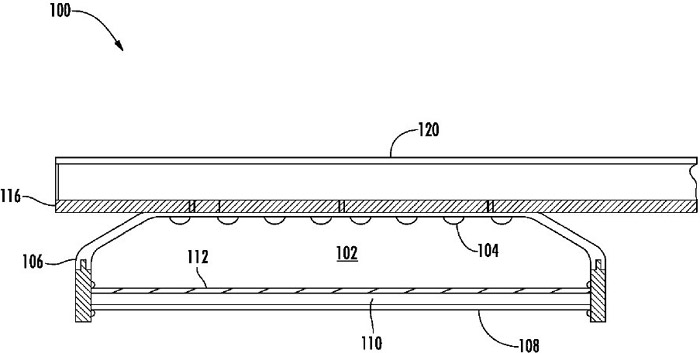Cree Hybrid LED-OLED White Light Patent Approved by USPTO
31-10-2014Leading U.S. LED chip manufacturer Crees patent application was recently approved by the United States Patent and Trademark Office (USPTO), the patented technology integrates LED with OLED technology to generate white light .
Crees OLED application is a significant development in the lighting industry, and might be signaling the early signs of the companys changing product strategy.
In the summary of the patent application, Cree explained the new invention provides solid state lighting system and or a lighting kit to generate white light by combining OLED lights with another solid state emitter, for instance a conventional LED. The OLED and other emitters are arranged spaced apart in a mixing chamber of the lighting kit to minimize color hot spots that can be found in typical LED emitters when using two different colors closely in a lighting.

A drawing of Crees latest OLED-LED patent. (Image Courtesy of USPTO)
Cree offers four types of prototypes for this new OLED-LED technology. In the first case the solid state emitter is a conventional LED packaged with phosphor to emit blue-shifted yellow light (BSY) as the first color, while the OLED is operable to emit red light as the second color of light. The two are combined to create white light with a Color Rendering Index (CRI) of 90. In some cases, the diffuser is placed near the substantially transparent substrate.
In the second prototype, the solid state emitters that emit the first color of light are phosphor free LEDs that are used in combination with a remote phosphor. The remote phosphor is placed near the OLED substrate. LEDs that emit the first color of light might be blue light, and the remote phosphor is used in combination with the LEDs to produce BSY light mixed with red light from OLED at the opening of the mixing chamber. A dichoric mirror is used in the opening of the mixing chamber, and placed between the substrate and remote phosphor, for example, a red dichroic mirror. The mirror prevents absorption of the red light by the mixing chamber, and devices or structures within.
In another example, the lighting system is based on two types of emitters used to make a lighting by providing the mixing chamber with a large number of emitters to emit light of the first wavelength, whether these are BSy emitters using a local phosphor, blue emitters, or other color emitting LEDs designed to work with a remote phosphor. The OLED on the transparent substrate is installed at the opening through which light exits the mixing chamber and the eventually the lighting. The mixing chamber is connected to a heat sink and power connections are provided to all emitters, the finished lighting kit may include a power supply or powered by a DC power system.
In the last example, the light from the blue-emitting LEDs in a lighting has a dominant wavelength from 435 to 490 nm, the light from the OLED has a dominant wavelength from 600 to 640 nm and the light from the phosphor has a dominant wavelength from 540 to 585 nm. In some cases, the light from the blue-emitting LEDs in a lighting has a dominant wavelength from 440 to 480 nm, the light from the OLED has a dominant wavelength from 605 to 630 nm and the light from the phosphor has a dominant wavelength from 560 to 580 nm.


